The following collection of activity sheets will teach your students how to spot and interpret homophones. Students will be asked to choose the correct word using sentence context clues. Activities include fill in the blank, choosing the correct term from a given word bank, defining given word sets, correcting erroneous words within a given sentence, and more. Answer keys have been provided for instructors. Extra project idea: Have your students construct a Venn diagram with homographs on one side, homophones on the other, and homonyms in the middle. Where do they see the overlap?
Print Homophone Worksheets
Click the buttons to print each worksheet and associated answer key.


Circle It
Circle the correct word to complete the sentence out of each pair of homonyms. This might take a minute to really kick in.

Choose the Correct One
You will find two choices available to complete each sentence. Chose the best word using the context clues that are available to you.

Lion Heart
I'm not lion to you! Are you lion to me? Read each sentence below. If the bolded word in the sentence is correct, put a check (√) on the line. If it is not correct, put an X on the line.
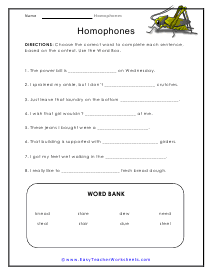
Word Bank
Choose the correct word to complete each sentence, based on the context. Use the Word Box. Word boxes can be helpful or a distraction, it is your choice.
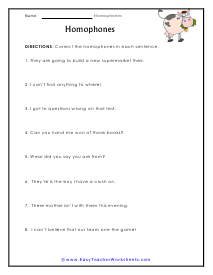
Milky Days
Correct the homophones in each sentence. Make sure that you can clearly read what is being asked of you.
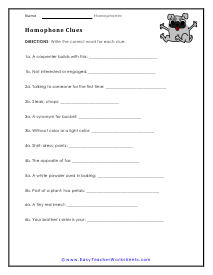
Clues
Clues can be helpful to try to understand the direction of the work. Write the correct word for each clue that is given.
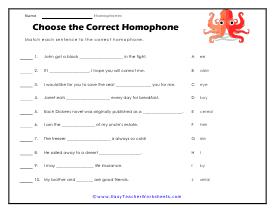
Choose the Correct One
These sentences are missing something. Fill in the sentence holes with one of the choices from the word bank.
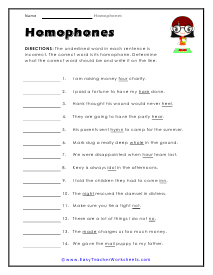
All Glasses!
The underlined word in each sentence is incorrect. Determine what the correct word should be and write it on the line. Then get after it and write it.
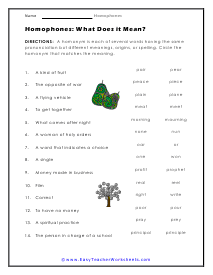
What Does it Mean?
See if you can understand what is meant by each sentence and then nail down the proper meaning.

Roots of Seams
Read each sentence. Choose the correct definition for the bold word. You will have to read into the context of the sentence in each case.
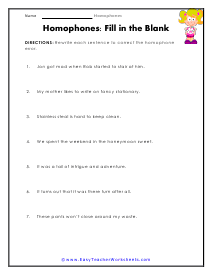
Fill in the Blank
Rewrite each sentence to correct the errors that are present. This is a good exercise on this skill and grammar together in one.
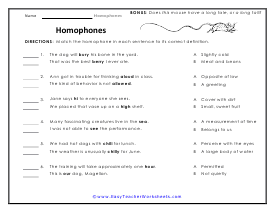
Mousy
Does this mouse have a long tale, or a long tail? Match the homophone in each sentence to its correct definition.
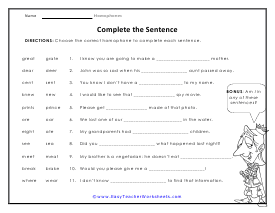
Complete the Sentence
Every sentence that you see here is missing something. Determine what it needs and beef it up.
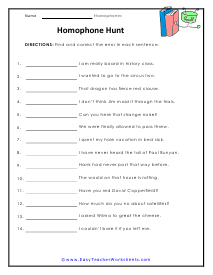
Why Are There Homophones?
When you are reading you will often come across words that are said aloud or pronounced the same way, but have completely different spellings, not only that they have completely different meanings. When it is dark out because the sun sets, we usually refer to that as night. Back in the twelfth century knights were the leaders of crusading armies. These two concepts are completely different, yet the subjects have totally distinct meanings. Homophones also are the culprit in many common misspellings. Examples include write and right, knot and not, flour and flower. It doesn't matter when you are speaking, but when you are writing, it makes all the difference in the world.
Don't get confused! We're not talking about homonyms here! Wait, can you tell the difference? No? Don't worry! We're here to guide you. Homophones can often be confusing, but it's also fun to learn how they work and what impact they create on the English Language.
Origin
Homo is derived from the Greek word that means 'same,' and phone is derived from the Greek word that means 'sound.' Quite literally, Homophone translates to 'same sound.'
In-Depth
Homophones are words that have different spellings and meanings, but they're pronounced the same way. For example:
I - Eye
Son - Sun
Die - Dye
Air - Heir
Board - Bored
When speaking, one can often get confused about how the word is being referred to. But that doesn't mean homophones should be eradicated from the English Language. There's no way to do that regardless, so we'll have to work around understanding how homophones work and why they exist in the first place.
Why Do They Exist?
Homophones exist to add a bit of humor to the English language. It creates an illusion and deceives the reader leaving them confused. Many people don't separate homophones, which ultimately affects the level of understanding one may have of the language.
The most common confusion that takes place is with regards to:
There - Their.
'There' means a place or a position.
'They' refers to someone's belonging or an association one may have with someone else.
These two homophones are poles apart with different spellings and meanings, but their pronunciation is the same. In games like a crossword puzzle, homophones play quite a role because of their ambiguity.
The Difference Between a Homophone and a Homonym
As discussed above, Homophones have the same sound but completely different pronunciation and spelling.
On the other hand, homonyms are words that have the same sound and spelling but have different meanings.
It is easy to get confused between homophones and homonyms but fret not! We're here to ease your worries.
Following are a few examples for you to refer to:
Homonyms
Rose - Flower
Rose - Rise, past tense
Homophones
Eight - A number
Ate - Eat, past tense
What's the Best Way To Make Yourself Familiar With Them?
You can insert homophones in crossword puzzles. This will confuse your friends, and they may write the wrong spelling. Homophones can be slightly confusing because of their nature, but they're fun to test out if you're hanging out with your friends.
The Importance of Them
What's important is that anyone who is studying or learning the language should know how to use them and where to use them. Reading through homophones and how they can sometimes be tricky will help broaden an individual's vocabulary, and it will help them learn different words.
This is to say that with every word, you learn another word. Slowly, gradually, this will increase an individual's IQ as well. Learning Homophones will enable the writer to figure out where they could potentially make mistakes.
Don't Feel Dejected
If you're not getting the hang of it now, don't feel dejected. The English Language is easy to talk in, but it has many facets when it comes to writing. They're a lot, but they're not complex. Take baby steps, and first understand the background of what you're learning. It makes the process so much easier.
Key Takeaways
The most significant learning here is to not fall for what you hear. Always double-check if you feel the need to. Don't question the existence of something but rather how you can work around it. The English Language is fun, and homophones add a touch of spice to it. They are an element of learning and growth, so understand their usage to the maximum.



